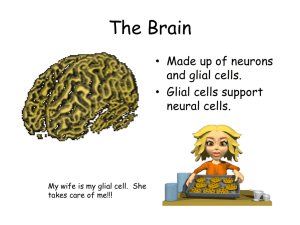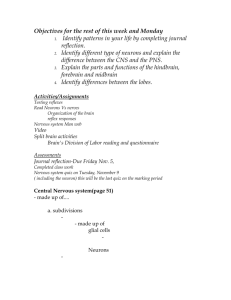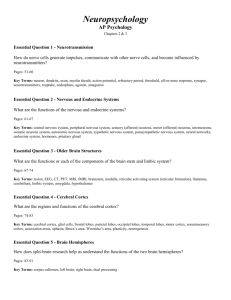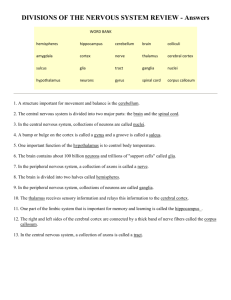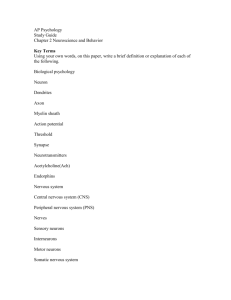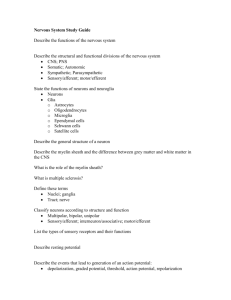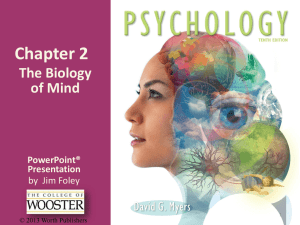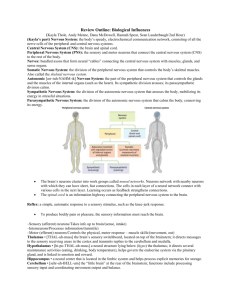Biological Bases of Behavior
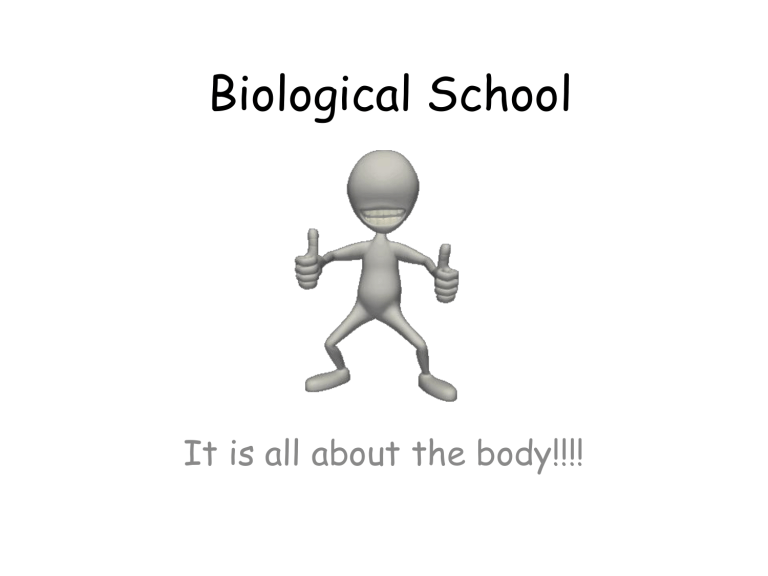
Biological School
It is all about the body!!!!
The Nervous System
It starts with an individual nerve cell called a NEURON.
Neuroanatomy
Synapse
Neurotransmitters (chemicals held in terminal buttons that travel through synaptic gap)
Synapse
How does a Neuron fire?
• Resting Potential: slightly negative charge.
• Reach the threshold when enough neurotransmitters reach dendrites.
• Go into Action Potential.
• All-or-none response.
• Transfer of ions across axon’s membrane causes electrical charge.
TYPES OF
NEUROTRANSMITTERS
Acetylcholine (ACH)
• Deals with motor movement and memory.
• Too much and you will….
• Too little and you will…
• Lack of ACH has been linked to
Alzheimer’s disease.
Dopamine
• Deals with motor movement and alertness.
• Lack of dopamine has been linked to
Parkinson’s disease.
• Too much has been linked to schizophrenia.
Serotonin
• Involved in mood control.
• Lack of serotonin has been linked to clinical depression.
Endorphins
• Involved in pain control.
• Many of our most addictive drugs deal with endorphins.
Drugs can be…..
• Agonists- make neuron fire
• Antagonists- stop neural firing
• Reuptake Inhibitors- block reuptake
Types of Neurons
• Efferent (Motor)
Neurons
• Interneurons
• Afferent (Sensory)
Neurons
The Nervous System
Central Nervous System
• The Brain and spinal cord
• CNS
Peripheral Nervous System
• All nerves that are not encased in bone.
• Everything but the brain and spinal cord.
• Is divided into two categories….somatic and autonomic.
Somatic Nervous System
• Controls voluntary muscle movement.
• Uses motor
(efferent) neurons.
Autonomic Nervous System
• Controls the automatic functions of the body.
• Divided into two categories…the
sympathetic and the parasympathetic
Sympathetic Nervous System
• Fight or Flight
Response.
• Automatically accelerates heart rate, breathing, dilates pupils, slows down digestion.
Parasympathetic Nervous System
• Automatically slows the body down after a stressful event.
• Heart rate and breathing slow down, pupils constrict and digestion speeds up.
Reflexes
• Normally, sensory
(afferent) neurons take info up through spine to the brain.
• Some reactions occur when sensory neurons reach just the spinal cord.
• Survival adaptation.
The Brain
• Made up of neurons and glial cells.
• Glial cells support neural cells.
My wife is my glial cell. She takes care of me!!!
Ways to study the Brain!!!
• Accidents: Phineas
Gage.
Lesions
Cutting into the brain and looking for change.
Brain tumors also lesion brain tissue.
Less Invasive ways to study the
Brain
• Electroencephalogram
(EEG)
• Computerized Axial
Tomography (CAT)
• Magnetic Resonance
Imaging (MRI)
• Positron Emission
Tomography (PET)
• Functional MRI
Brain Structures
• Some scientists divide the brain up into three parts.
• Hindbrain
• Midbrain
• Forebrain
Medulla Oblongata
• Heart rate
• Breathing
• Blood Pressure
Pons
• Connects hindbrain, midbrain and forebrain together.
• Involved in facial expressions.
Cerebellum
• Located in the back of our head- means little brain.
• Coordinates muscle movements.
• Like tracking a target.
Midbrain
• Coordinates simple movements with sensory information.
• Contains the
reticular formation: arousal and ability to focus attention.
Thalamus
• In Forebrain
• Receives sensory information and sends them to appropriate areas of forebrain.
• Like a switchboard.
• Everything but smell.
Limbic System
• EMOTIONAL
CONTROL CENTER of the brain.
• Made up of
Hypothalamus,
Amygdala and
Hippocampus.
Hypothalamus
• Pea sized in brain, but plays a not so pea sized role.
• Body temperature
• Hunger
• Thirst
• Sexual Arousal
(libido)
• Endocrine System
Hippocampus and Amygdala
• Hippocampus is involved in memory processing.
• Amygdala is vital for our basic emotions.
Cerebral Cortex
• Top layer of our brain.
• Contains wrinkles called fissures.
• The fissures increase surface area of our brain.
• Laid out it would be about the size of a large pizza.
Hemispheres
• Divided into a left and right hemisphere.
• Contralateral controlled- left controls right side of body and vice versa.
• Brain Lateralization.
• Lefties are better at spatial and creative tasks.
• Righties are better at logic.
Split-Brain Patients
• Corpus Collosum attaches the two hemispheres of cerebral cortex.
• When removed you have a split-brain patient.
Areas of the Cerebral Cortex
• Divided into eight lobes, four in each hemisphere (frontal, parietal, occipital and temporal).
• Any area not dealing with our senses or muscle movements are called association
areas.
Frontal Lobe
• Deals with planning, maintaining emotional control and abstract thought.
• Contains Broca’s Area.
• Broca’s Aphasia.
• Contains Motor
Cortex.
Parietal Lobes
• Located at the top of our head.
• Contains the somatosensory cortex.
• Rest are association areas.
Temporal Lobes
• Process sound sensed by ears.
• Not lateralized.
• Contains Wernicke’s area.
• Wernicke’s Aphasia.
Occipital Lobes
• In the back of our head.
• Handles visual input from eyes.
• Right half of each retina goes to left occipital lobe and vice versa.
Brain Plasticity
• The ability for our brains to form new connections after the neurons are damaged.
• The younger you are, the more plastic your brain is.
Endocrine System
• System of glands that secrete hormones.
• Controlled by the hypothalamus.
• Ovaries and Testes.
• Adrenal Gland
Genetics
• Every human cell contains 46 chromosomes (23 pairs).
• Made up of deoxyribonucleic acid-
DNA.
• Made up of Genes.
• Made up of nucleotides.
Twins
• Best way to really study genetics because they come from the same zygote.
• Bouchard Study
• .69 Correlational coefficient for IQ tests of identical twins raised apart.
• .88 raised together.
Chromosomal Abnormalities
• Gender comes from
23 rd pair of chromosomes…men have XY…woman have
XX.
• Turner’s syndrome is single X.
• Klinefelter’s syndrome is extra X…XXY
• Down syndrome….extra chromosome on 21 st pair.

